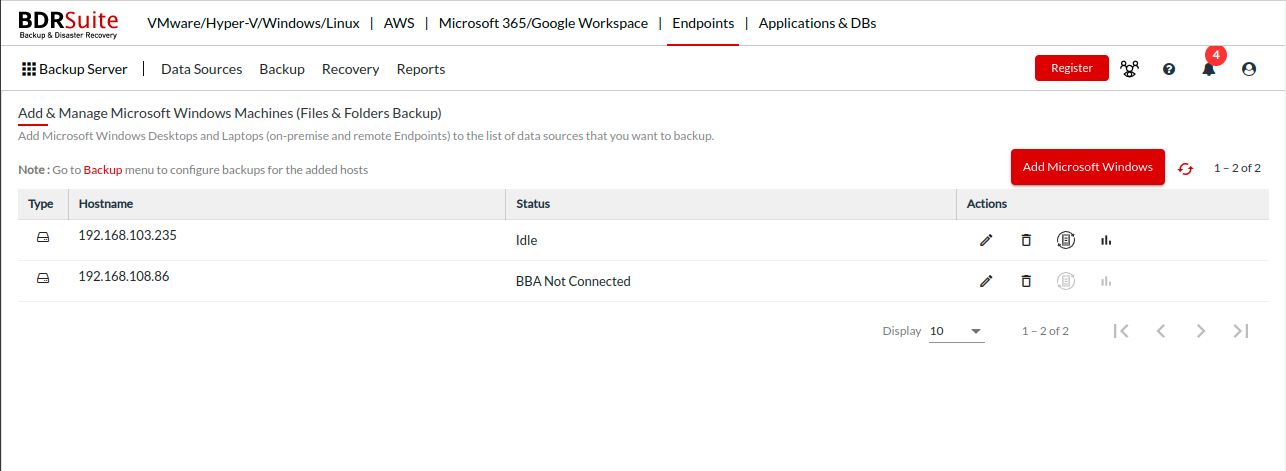Adding Backup Agents Manually
BDRSuite Backup Agent (BBA) Installation on Individual Backup Hosts
1. Download BDRSuite Backup Agent (BBA) based on the host OS (Windows, Linux, Mac) from the backup server console.
2. Locate the downloaded BBA setup file on the backup host and run it.
3. Follow the on-screen instructions to proceed with the installation.
4. During the installation process, you will be prompted to enter the following information:
Display Name: Provide a name to identify the host in the backup server.
Backup Server DNS Name/IP Address: Enter the DNS Name or IP Address of the BDRSuite Backup Server to register this host with the backup server.
5. Complete the installation process by providing the necessary information and following any additional prompts.
6. Once the installation is successful, the BBA will automatically establish a connection and register the host with the backup server.
7. To verify the installation and connection, access the backup server's web interface and navigate to the "Data Sources" menu.
8. In the "Data Sources" section, you will see the host details, including the display name, Hostname/IP address, and connection status.
By following these steps, you can install and configure the BDRSuite Backup Agent (BBA) on individual backup hosts, allowing them to connect to the BDRSuite Backup Server for backup operations.
Bulk Installation of BDRSuite Backup Agent (BBA)
Download BBA and install it on multiple backup hosts simultaneously using the below commands through any third party tool.
Windows
To configure disk image backup and reboot the host immediately after BBA installation, use the command below:
| msiexec /i BDRSuite_Delegation_Service_x_x_x_x_x.msi /qn BACKUPSERVERINFO="Enter Backup Server IP Address/DNS Name" REBOOT="Force" INSTALLDRIVER="Yes" |
|---|
To configure disk image backup and to reboot the host later, use the command below:
| msiexec /i BDRSuite_Delegation_Service_x_x_x_x_x.msi /qn BACKUPSERVERINFO="Enter Backup Server IP Address/DNS Name" INSTALLDRIVER="Yes" |
|---|
To configure only files & folders backup, use the command below:
| msiexec /i BDRSuite_Delegation_Service_x_x_x_x_x.msi /qn BACKUPSERVERINFO="Enter Backup Server IP Address/DNS Name" |
|---|
Where xxxxx is the BBA installer version. The latest version is 5602 (v5.6.0.2 )
Example:
| msiexec /i BDRSuite_Delegation_Service_5_6_0_2_U2.msi /qn BACKUPSERVERINFO=192.168.100.123 |
|---|
Linux
| bash BDRSuite_Delegation_Service_5_6_0_2_U2_DBN.bin yes admin "/home/vembuintegrationservice" "{Enter Backup Server IP Address/DNS Name}" |
|---|
Mac
| sudo sh BDRSuite_Delegation_Service_5_6_0_2_U2_IMac_arm64.bin "{Enter Backup Server IP Address/DNS Name}" |
|---|
To proceed further and know about the detailed instructions on Bulk Installation, click here and follow from Step 1.
Establishing Connection between the backup host and backup server
BBA installed on each backup host will automatically connect to the backup server.
1.If the BBA on the backup host is successfully connected to the BDRSuite Server, then the status will be shown as 'Idle’.

2.If the backup host is not connected, then the status will be shown as 'BBA Not Connected'. In this case, ensure the following on the backup host:
Make sure BDRSuite Backup Agent(BBA) (runs with service name:BDRSuite Delegation Service) is installed. Make sure the ‘BDRSuite Delegation Service’ status is running. |
|---|
3.BBA installed on the backup host uses port 32005 to communicate with the BDRSuite Server. To check whether the port is open for communication between the backup host and backup server, open Command Prompt on the backup host and execute the following command.
| telnet [BDRSuite Server IP Address/DNS Name] [port] |
|---|
If the port is not accessible, it can be due to the firewall settings. Make sure your firewall rules allow port 32005 to be open for communication.
4.If the connection to the backup host has still not been established, please check the logs on the location below for more information. The errors you may encounter in the logs while adding hosts are listed below along with the solutions.
Backup host:
Windows Log Location: <installation location>\Vembu\VembuIntegrationService\log\server.log Example: C:\ProgramFiles\Vembu\VembuIntegrationService\log\server.log Linux Log Location:<installationlocation>/vembuintegrationservice/Vembu/VembuIntegrationService/log/server.log Example: /home/vembuintegrationservice/Vembu/VembuIntegrationService/log/server.log |
|---|
BDRSuite Backup Server:
Windows Log Location: <installation location>\Vembu\VembuBDR\log\server.log Example: C:\Program Files\Vembu\VembuBDR\log\server.log Linux Log Location: /<installation location>/vembubdr/Vembu/VembuBDR/log/server.log Example: /home/vembubdr/Vembu/VembuBDR/log/server.log |
|---|
How to resolve the issues you run into when adding backup hosts
Error 117073: Unable to find the host - {Hostname/IP}. Make sure the host is added to the BDRSuite Server. --- To resolve this issue, make sure you add the host details and save them on the backup server under the Data Sources menu
Error 117074: Unable to connect to the BDRSuite Server. Make sure the BDRSuite Server is up and running. --- To resolve this issue, make sure you have specified the valid backup server IP address/DNS name and BDRSuite service is up and running.
Error 117076: BDRSuite Server isn't compatible with the BDRSuite Delegation Service (BDS) version running on the target host. Make sure the BDS runs the same or lower version than BDRSuite Server. --- To resolve this issue, ensure the BDRSuite Delegation Service runs on the same or lower version than the BDRSuite Server.
Error 117072: Unable to register the target host as another host with the same BIOS UUID added already. Hosts with unique BIOS UUID can only be added/registered to the BDRSuite Server. --- You can only add hosts that have unique BIOS UUID.
Error 117011: Unsupported Operating System for backup. --- Check the supported OS here.